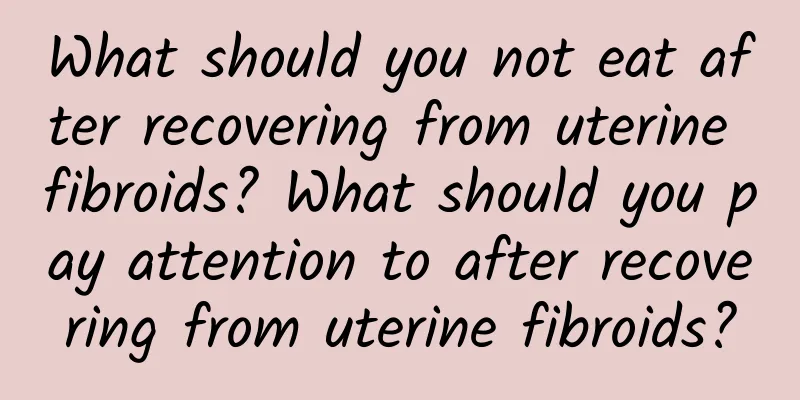What is uterine fibroid bleeding? What are the symptoms of uterine fibroid bleeding?

|
What is uterine fibroid bleeding? Uterine fibroid bleeding refers to the bleeding of fibroids in the myometrium of the uterus during menstruation. Uterine fibroid bleeding is one of the common gynecological diseases, which has a certain impact on women's health. The following will introduce the symptoms and treatment methods of uterine fibroid bleeding. 1. What is uterine fibroid bleeding Uterine fibroids are a type of muscle tumor that occurs in the uterine lining and are very common in women of childbearing age. Uterine fibroid bleeding refers to the spontaneous rupture or bleeding of uterine fibroids during the menstrual cycle, accompanied by pain. Usually this bleeding is accompanied by dysmenorrhea during the menstrual cycle. 2. Symptoms of uterine fibroid bleeding 1. Irregular menstruation Uterine fibroid bleeding can cause irregular menstruation, such as shortened or prolonged menstrual cycles, increased or decreased menstrual blood volume. Sometimes amenorrhea or abnormal bleeding may also occur. This is one of the most common symptoms of uterine fibroid bleeding. 2. Abdominal pain Uterine fibroid bleeding can cause abdominal pain symptoms, the degree of pain will vary depending on the size and location of the uterine fibroids. Some patients will experience cyclical abdominal pain, similar to the feeling of menstrual cramps. 3. Compression symptoms Bleeding from uterine fibroids can cause the uterus to enlarge, compress surrounding tissues, and cause symptoms such as frequent urination and constipation. Sometimes, there will be back pain and discomfort in the lower abdomen. 3. Treatment of uterine fibroid bleeding 1. Medication For mild uterine fibroid bleeding, oral medications can be used to control symptoms, such as some drugs that promote uterine contraction, or drugs used to reduce menstrual volume. However, it should be noted that drug treatment can only relieve symptoms, not cure them. 2. Surgery For more severe symptoms of uterine fibroid bleeding, or with other complications, surgical treatment may be required. Surgery can choose to remove the uterine fibroids, or remove the entire uterus. Surgery can completely solve the problem of uterine fibroids, but it will affect women's fertility, so it needs to be carefully considered. 3. Interventional treatment For some high-risk patients who are not suitable for surgery, interventional treatment can be chosen, that is, tiny particles are implanted in the uterine artery through a catheter to block the blood supply artery and reduce bleeding. This method is a non-surgical treatment and is a good choice for patients who are not suitable for surgery. Uterine fibroid bleeding refers to the bleeding of fibroids in the myometrium of the uterus during menstruation. Its symptoms mainly include irregular menstruation, abdominal pain and compression symptoms. Treatment methods include drug therapy, surgical treatment and interventional treatment. Patients can choose the appropriate treatment method according to their own conditions. Only by fully understanding the symptoms and treatment methods of uterine fibroid bleeding can we deal with the disease in time and protect women's health. |
Recommend
What causes ectopic pregnancy?
Ectopic pregnancy is a very difficult disease. Th...
Help you understand the examination items for dysmenorrhea
Dysmenorrhea is a common symptom of women during ...
Causes of ectopic pregnancy in patients with ectopic pregnancy
Ectopic pregnancy occurs to most people in life. ...
What should I not eat if I have uterine fibroids? Is uterine fibroids okay after the age of 45?
What should I not eat if I have uterine fibroids?...
Let's take a closer look at the causes of habitual miscarriage.
Many women often experience miscarriage after bec...
Green latte detoxifies and gets rid of fat! Drink for 10 days without going hungry
Drinking a cup of latte every day to refresh your...
What medicine is effective for treating cervical erosion? Introducing the treatment medicines for cervical erosion at different stages
Cervical erosion is a common disease among women....
Why does menstruation not come after medical abortion? It may be due to the following two reasons
Medical abortion has been widely used in clinic i...
What is the reason for prolonged menstruation?
What is the reason for prolonged menstruation? Pr...
Eating too much rice dumplings can cause indigestion, be careful of these 5 symptoms! Nutritionist Ricky: 4 tips to eat zongzi without burden
The Dragon Boat Festival holiday is approaching, ...
What is right ovarian cyst and what are its clinical symptoms
What is a right ovarian cyst? What are the clinic...
Severe cervical erosion will turn into cancer in a few years. Will cervical erosion cause cancer?
Severe cervical erosion does not cause cancer. Ca...
Does adenomyosis cause frequent urination and pain?
Does adenomyosis cause frequent urination and pai...
What are the complications of female pelvic peritonitis?
Any disease that is not treated in time will lead...
Why can exercise build muscle and reduce fat?
Muscles are the armor of the human body. If we us...









